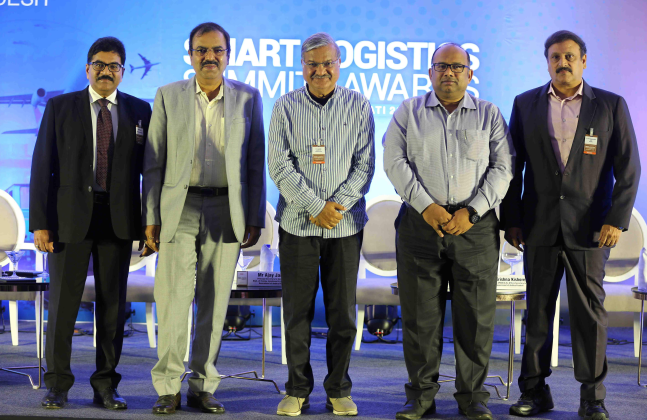Initiatives being taken by formulating policies and developing infrastructure to reduce production and logistics cost for making Andhra Pradesh a logistics hub were detailed
Within few years of formation the sunrise state of Andhra Pradesh is surging to become a global logistics and transshipment hub, under the visionary leadership of honourable Chief Minister N Chandrababu Naidu, informed R Ramprasad, Editor-in-Chief and Publisher, Maritime Gateway, setting the conference in context. World class logistics and storage infrastructure is being planned and developed close to the cargo generation and consumption centers, to ensure time and cost efficient logistics services are provided to the exim community in the state and the surrounding hinterland. Today globally the focus is on developing efficient infrastructure that enables ease of doing business, reduce inefficiency in cargo movement, bringing down the cost of logistics through digitalisation using cutting edge technologies such as BlockChain and IoT.
S P Tucker, IAS (Retd), Former Chief Secretary, Government of Andhra Pradesh and Executive Vice Chairman, AP Economic Development Board, shared the vision of Chief Minister, N Chandrababu Naidu to develop Andhra Pradesh into a logistics hub not only for India but also for South Asia. Citing example of Singapore he said, the city nation has emerged as a logistics hub decades back due to favourable policy structure, use of IT, skilled manpower and standards for logistics and warehousing were developed. Andhra Pradesh has been recording about 11 to 12 per cent growth in GDP for the past 3-4 years and will soon be the first developed state of India. The state government has linked up with Germany, Russia and US for improving the standard of education in universities. To become a hub in pharma sector, 3-4 mega pharma parks are being developed in Nellore Praksam and Vizag. To become a logistics hub Andhra Pradesh will need trained manpower, simplified laws for companies to set up base here, financial support system, faster decision making and turnaround time should be standardised for all things. State highways are planned coming from Kurnool, Ananthapur upto Amaravati. Areas where warehousing, godowns are required are being mapped and these developments have led to the double digit growth of the state. Two support departments are planned – one for transport and another for ports. Cargo generation and export centers are being mapped and what part of it is being generated in Andhra Pradesh and can move via the state is being studied.

The main challenge before the country today is job creation, shared Ajay Jain, IAS, Principal Secretary to Govt – Energy, Investment & Infrastructure, Government of Andhra Pradesh. Primary sector has its own limitations, due to mechanisation and automation not many jobs are being created in the manufacturing sector. Further our products can compete globally if their cost is less, which again points at reducing the logistics cost. This way India can also be promoted as a global manufacturing hub like China. AP has ideal location on east coast with one major and 5 non-major ports and another 4 ports are coming at Bhavanapadu, Srikakulam, Kakinada and Machilipatnam. The existing major ports have posted 9 per cent growth and private ports have put double digit growth. Along with ports MMLPs are required and CONCOR has developed facilities at Vizag, Kakinada and Krishnapatnam. The VCIC and CBIC corridors will boost further industrial growth, to support which a comprehensive logistics policy is required.
“Logistics sector has become vibrant for the past 3-4 years across the country and there has been a lot of improvement in the ports sector, connecting directly into the hinterland and waterways,” said Dr Koya Praveen, IPS, Director of Ports, Government of Andhra Pradesh.
The cement cluster of Jaggampeta is being connected to Amaravati and Vijayawada. Six months back the first Ro-Ro in the state has been operationalized between Vijayawada and Amaravati. This is also saving the transportation cost in construction of the new capital city. To succeed as an export-led economy, a robust manufacturing sector is required which can be competitive if logistics cost is low. Logistics cost in India accounts for 17 per cent whereas the world average is 12 per cent. A comprehensive logistics policy needs to be developed for port-led development with forward and backward integration. 50 per cent of cargo movement from India is east bound but is moving from west coast of India, so Andhra Pradesh needs to be connected to Central and Northern India.
“Using the coast line and connecting it to the hinterland can help in making Andhra Pradesh a logistics hubs. Logistics cost in India cannot come down unless end-to-end logistics is developed,” revealed V Kalyana Rama, CMD, CONCOR. In India logistics is disjointed and an integrated solution is required. Elaborating on logistics services of CONCOR in Andhra Pradesh he said, an MMLP is developed in Visakhapatnam on 100 acres along with road and rail connectivity at a CAPEX of 420 crores. The idea is to promote aggregation and distribution through modal shift from road to rail and reduce the logistics cost. It will have three EXIM warehouses of 5075 sq.mts each, bonded area of 1211 sq.mts and state-of-the-art cargo handling equipment. Nepal is using this facility in moving its exim cargo.
CONCOR is operating another CFS facility in Vizag since 2005, which is spread on 89.35 acres and developed at a CAPEX of 9.6 crores. An MMLP in Krishnapatnam is being developed on 153 acres, at a CAPEX of 70 crores. In Guntur CONCOR has taken over an ICD from Indian Railways. The vision of CONCOR is to graduate from terminal operations to distribution logistics, as such services are still not well developed in India. In India a lot of agri-produce is wasted and this sector is in urgent need for good distribution logistics.
Another initiative of Concor Kalyana Rama informed was to expand non-rail business of Concor by expanding warehousing. The plan is to grow warehousing operations from 3.5 million sq.ft to 50 million sq.ft on distribution logistics model. Warehouses will also be set up through PPP mode and facilities will be hired on revenue sharing basis. India still has a huge requirement for warehousing and additional one billion sq.mts of warehousing needs to be developed.
He also hinted at the need to fully exploit the potential in coastal shipping. Cargo can be moved from Kandla to Tuticorin by developing a north-south movement model using rail, road and coastal shipping. Another initiative of Concor is to develop an Integrated Logistics Manufacturing Zone (ILMZ) that will support for complete in-bound and out-bound logistics – procuring raw material and shipping out finished goods. A MoU with the government of Andhra Pradesh has been signed for this purpose.

J Krishna Kishore, CA, IRS, CEO, APEDB & Ex-Officio Secretary to Government of Andhra Pradesh, looked back into the memory lane at the difficulties faced when the sunrise state of Andhra Pradesh was newly formed in 2014. The state then had a budget deficit with only 43 per cent of its revenues and assets were lesser than the liabilities. But the state has covered a long revival journey in a short span of time and is surging to become the top state in India by 2020. By 2050, Andhra Pradesh aims to become a leading global economic destination. In the past four years Andhra Pradesh has not witnessed any power cuts which is a major achievement. Coming to economic growth, from 1947 to 2014 the state had an economic growth of $80 billion, where as in the past four years (2014-2018) there has been a 60 per cent rise in economic growth touching at $124 billion. The percapita income of the state has also increased by 60 per cent and by 2028 the state plans to become a trillion Dollar economy.
To develop Andhra Pradesh into one of the best logistics hub in the world, four airports are already under development, 14 seaports are being developed and 20,000km of roads are being layed. About 888kms of inland waterways are being made navigable and the state is already the no.1 in ease of doing business.
“Industrialisation is the corner stone for economic development. Industry, infrastructure and logistics need to be interconnected as growth in industries will result in more business that will generate greater profits and revenue generation,” revealed K V Satyanarayana, IAS, Managing Director, Andhra Pradesh State Warehousing Corporation. Most of the Indian economy comprises of informal sector (about 60 per cent), which includes logistics as well. The state government is creating a separate department for logistics sector. The state has warehousing capacity of 13 lakh tonnes and additional 5 lakh tonnes will come up soon that will house all types of cargo – containerised, bulk, break bulk, liquid.







